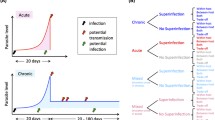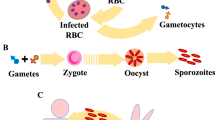Abstract
An analytically feasible, deterministic model for the spread of drug resistance among human malaria parasites, which incorporates all characteristics of the complex malaria-transmission cycle was introduced by Schneider and Kim (Theor. Popul Biol, 2010). The model accounts for the fact that only a fraction of infected hosts receive drug treatment and that hosts can be co-infected by differently many parasites. Furthermore, the model also incorporates host heterogeneity. Antimalarial-drug resistance is assumed to be caused by a single locus with two alleles—a sensitive one and a resistance one. The most important result for this model is that an analytical solution for the frequencies of a linked neutral biallelic locus exists. However, the exact solution does not admit an explicit form, and cannot straightforwardly be interpreted in terms of the model parameters. Here, we establish simple approximations for the equilibrium frequency at the neutral locus. Under the assumption that the resistant allele is initially rare—the biologically most relevant assumption in this context—and that recombination is weak, the approximations become similar to the approximations in the standard hitchhiking model. However, there are crucial differences. In particular, because of the high degree of selfing among malaria parasites in their sexual phase, a genome-wide reduction of relative heterozygosity occurs if selection is sufficiently strong. It turns out that the approximations are accurate even if the recombination rates are not small and the resistant allele is initially not very rare. The main advantage of our approximations is that they are easy to interpret in terms of model parameters. Moreover, they allow to make predictions of the size of the valley of reduced heterozygosity around the selected locus for given model parameters. Reversely, for a given reduction of heterozygosity, it is possible to identify the corresponding parameters. Moreover, we will show that incorporating host heterogeneity leads to an increased hitchhiking effect.
Similar content being viewed by others
References
Barton NH (2000) Genetic hitchhiking. Philos Trans R Soc Lond B Biol Sci 355(1403):1553–1562. http://rstb.royalsocietypublishing.org/content/355/1403/1553.abstract
Betancourt AJ, Kim Y, Orr HA (2004) A pseudohitchhiking model of X vs. autosomal diversity. Genetics 168(4):2261–2269. http://www.genetics.org/cgi/content/abstract/168/4/2261
Brooks DR, Wang P, Read M, Watkins WM, Sims PFG, Hyde JE (1994) Sequence variation of the hydroxymethyldihydropterin pyrophosphokinase: dihydropteroate synthase gene in lines of the human malaria parasite Plasmodium falciparum with differing resistance to sulfadoxine. Eur J Biochem 224(2):397–405. http://dx.doi.org/10.1111/j.1432-1033.1994.00397.x
Chevin L-M, Hospital F (2008) Selective sweep at a quantitative trait locus in the presence of background genetic variation. Genetics 180(3):1645–1660. http://www.genetics.org/cgi/content/abstract/180/3/1645
Cowman AF, Morry MJ, Biggs BA, Cross GA, Foote SJ (1988) Amino acid changes linked to pyrimethamine resistance in the dihydrofolate reductase-thymidylate synthase gene of Plasmodium falciparum. Proc Natl Acad Sci USA 85(23):9109–9113. http://www.pnas.org/content/85/23/9109.abstract
Daily JP (2006) Antimalarial drug therapy: the role of parasite biology and drug resistance. J Clin Pharmacol 46(12):1487–1497. http://jcp.sagepub.com/cgi/content/abstract/46/12/1487
Escalante AA, Smith DL, Kim Y (2009) The dynamics of mutations associated with anti-malarial drug resistance in plasmodium falciparum. Trends Parasitol 25(12):557–563. http://www.sciencedirect.com/science/article/B6W7G-4XJ9BS6-1/2/04d13d69d2006be02c12ef0d051cc5c6
Hastings IM (2003) Response to: the puzzling links between malaria transmission level and drug resistance. Trends Parasitol 19(4):160–161. http://www.sciencedirect.com/science/article/B6W7G-483SMKD-1/2/680a5da4f74f112c6e1b87c270a9921d
Hastings IM (2006) Complex dynamics and stability of resistance to antimalarial drugs. Parasitology 132(05):615–624. http://journals.cambridge.org/action/displayAbstract?fromPage=online&aid=428221&fulltextType=RA&fileId=S0031182005009790
Hastings IM, Mackinnon MJ (1998) The emergence of drug-resistant malaria. Parasitology 117(05):411–417. http://journals.cambridge.org/action/displayAbstract?fromPage=online&aid=24263&fulltextType=RA&fileId=S0031182098003291
Hastings IM, Watkins WM, White NJ (2002) The evolution of drug-resistant malaria: the role of drug elimination half-life. Philos Trans R Soc Lond B Biol Sci 357(1420):505–519. http://rstb.royalsocietypublishing.org/content/357/1420/505.abstract
Hedrick PW (1980) Hitchhiking: a Comparison of Linkage and Partial Selfing. Genetics 94(3):791–808. http://www.genetics.org/cgi/content/abstract/94/3/791
Hermisson J, Pennings PS (2005) Soft sweeps: molecular population genetics of adaptation from standing genetic variation. Genetics 169(4):2335–2352. http://www.genetics.org/cgi/content/abstract/169/4/2335
Kim Y, Stephan W (2002) Detecting a local signature of genetic hitchhiking along a recombining chromosome. Genetics 160(2):765–777. http://www.genetics.org/cgi/content/abstract/160/2/765
Korenromp E, Miller J, Nahlen B, Wardlaw T, Young M (2005) World malaria report 2005. World Health Organization (WHO), Geneva
Mackinnon MJ, Hastings IM (1998) The evolution of multiple drug resistance in malaria parasites. Trans R Soc Tropical Med Hygiene 92(2):188–195. http://www.sciencedirect.com/science/article/B75GP-4BY31N7-MS/2/bfd1e32b1cf5fd0f23e10978a356bd36
Marsh K (1998) Malaria disaster in africa. Lancet 352(9132):924–924. http://www.sciencedirect.com/science/article/B6T1B-4FWV357-JX/2/c9facab67b868b8fddd289f050bfae19
Maynard Smith J, Haigh J (1974) The hitch-hiking effect of a favourable gene. Genet Res 23(01):23–35. http://journals.cambridge.org/action/displayAbstract?fromPage=online&aid=1754360&fulltextType=RA&fileId=S0016672300014634
McCollum AM, Basco LK, Tahar R, Udhayakumar V, Escalante AA (2008) Hitchhiking and selective sweeps of Plasmodium falciparum sulfadoxine and pyrimethamine resistance alleles in a population from Central Africa. Antimicrob Agents Chemother 52(11):4089–4097. http://aac.asm.org/cgi/content/abstract/52/11/4089
Mita T, Tanabe K, Takahashi N, Tsukahara T, Eto H, Dysoley L, Ohmae H, Kita K, Krudsood S, Looareesuwan S, Kaneko A, Bjorkman A, Kobayakawa T (2007) Independent evolution of pyrimethamine resistance in Plasmodium falciparum isolates in Melanesia. Antimicrob Agents Chemother 51(3): 1071–1077. http://aac.asm.org/cgi/content/abstract/51/3/1071
Nair S, Nash D, Sudimack D, Jaidee A, Barends M, Uhlemann A-C, Krishna S, Nosten F, Anderson TJC (2007) Recurrent gene amplification and soft selective sweeps during evolution of multidrug resistance in malaria parasites. Mol Biol Evol 24(2):562–573. http://mbe.oxfordjournals.org/cgi/content/abstract/24/2/562
Nair S, Williams JT, Brockman A, Paiphun L, Mayxay M, Newton PN, Guthmann J-P, Smithuis FM, Hien TT, White NJ, Nosten F, Anderson TJC (2003) A selective sweep driven by pyrimethamine treatment in Southeast Asian malaria parasites. Mol Biol Evol 20(9):1526–1536. http://mbe.oxfordjournals.org/cgi/content/abstract/20/9/1526
Nash D, Nair S, Mayxay M, Newton PN, Guthmann J-P, Nosten F, Anderson TJ (2005) Selection strength and hitchhiking around two anti-malarial resistance genes. Proc R Soc B Biol Sci 272(1568):1153–1161. http://rspb.royalsocietypublishing.org/content/272/1568/1153.abstract
Prugnolle F, Durand P, Renaud F, Rousset F (2009) Effective size of the hierarchically structured populations of the agent of malaria: a coalescent-based model. Heredity 1–7. http://dx.doi.org/10.1038/hdy.2009.127
Schneider KA, Kim Y (2010) An analytical model for genetic hitchhiking in malaria parasites caused by drug resistance. Theor Popul Biol
Schwobel B, Alifrangis M, Salanti A, Jelinek T (2003) Different mutation patterns of atovaquone resistance to Plasmodium falciparum in vitro and in vivo: rapid detection of codon 268 polymorphisms in the cytochrome b as potential in vivo resistance marker. Malaria J 2(1):5. http://www.malariajournal.com/content/2/1/5
Stephan W, Wiehe THE, Lenz MW (1992) The effect of strongly selected substitutions on neutral polymorphism: analytical results based on diffusion theory. Theor Popul Biol 41(2):237–254. http://www.sciencedirect.com/science/article/B6WXD-4F1Y9N0-3M/2/1245281bba0c6b542457fdd75c343edf
Triglia T, Cowman AF (1994) Primary structure and expression of the dihydropteroate synthetase gene of Plasmodium falciparum. Proc Natl Acad Sci USA91(15):7149–7153. http://www.pnas.org/content/91/15/7149.abstract
WHO (2000) WHO Expert Committee on malaria. World Health Organ Tech Rep Ser 892:1–74. http://www.genetics.org/cgi/content/abstract/160/2/765
Wootton JC, Feng X, Ferdig MT, Cooper RA, Mu J, Baruch DI, Magill AJ, Su X-z 07 2002 Genetic diversity and chloroquine selective sweeps in Plasmodium falciparum. Nature 418(6895):320–323. http://dx.doi.org/10.1038/nature00813
Author information
Authors and Affiliations
Corresponding author
Rights and permissions
About this article
Cite this article
Schneider, K.A., Kim, Y. Approximations for the hitchhiking effect caused by the evolution of antimalarial-drug resistance. J. Math. Biol. 62, 789–832 (2011). https://doi.org/10.1007/s00285-010-0353-9
Received:
Revised:
Published:
Issue Date:
DOI: https://doi.org/10.1007/s00285-010-0353-9
Keywords
- Selective sweep
- Co-infections
- Drug concentration
- Relative heterozygosity
- Host heterogeneity
- Malaria
- Plasmodium falciparum




